Awareness, uptake and use of the scheme
Awareness of the Young Persons’ Free Bus Travel
Awareness of the Young Persons' Free Bus Travel Scheme was high. Of the 10,821 follow-up survey respondents who answered this question, 86% had heard of the scheme, compared to 10% who had not heard of it and 4% who were not sure. This represented a 19 percentage point increase in awareness since the baseline survey, when 67% of respondents had heard of the scheme.
Similarly, all focus group participants indicated that they had heard of the scheme, including those who used it, those who were eligible but did not use it, and those who were older than 21 years old and so were ineligible for the scheme. Participants indicated that they had generally heard of the scheme either via their own/their child’s school or from the news or social media. Some non-users had heard about it from other people who were eligible and/or already using the scheme.
While general awareness of the existence of the scheme was high, focus group findings suggest that awareness of the scheme’s stated aims and objectives, as well as any restrictions around usage were typically less well known or understood among the general public. Some had a vague idea, or assumed that the scheme aimed to make transport more affordable for children and young people and support access to services and opportunities. Among focus group participants who were eligible but did not use the scheme, there was confusion and uncertainty around the exact ages for eligibility, which bus services could be used and which were out of scope, if there were time periods over the day/week where the pass could not be used, if the pass could be used on longer-distance routes/services, etc., with more information desired in this respect.
There was, however, general support for the scheme, especially for encouraging young people to use buses, both as a greener form of transport and to allow them to access opportunities:
“It’s indoctrinating our youth to first of all think bus before persuading their parents to give them a lift… during lockdown everyone dropped out of using public transport because it was a risky thing to do, and I think… it is actually a good idea to get the young ones used to using buses, like we always used to when we were young, and it’s a greener travel choice.” (Other Bus User)
Respondents across both the follow-up survey and focus groups were largely positive about the schemes ability to provide greater access to services, social, education, employment and leisure opportunities; and were highly supportive of the potential financial savings for young people and their families related to transport. While not an issue specifically asked about, a few focus group respondents also outlined support for the universal nature of the scheme, meaning they could consider travelling and activities as a group while being sure that no one would be excluded due to their financial situation:
“Benefits primarily are increases in access to the surrounding area and the opportunities therein… removing the financial barrier and generally just increasing freedom to travel.” (Scheme User)
Only a small minority of follow-up survey respondents and focus group participants (from the older ‘other bus users’ group) were negative about the scheme. Generally these respondents disagreed with the universal nature of the scheme, felt that taxpayer’s money could be better spent, were concerned about the impact on other age groups/passengers, or worried that levels of walking and cycling may reduce among young people.
Uptake of the Young Persons’ Free Bus Travel Scheme
Uptake data indicated that the total national uptake rate was 59% among all 5-21 year olds by the end of April 2023. This ranged from 53% of 5-15 year olds to 70% of 16-21 year olds.
Large variations were also found between local authorities (see Figure 1). Those areas with the highest uptake included Edinburgh (83%), Inverclyde (82%), and North Ayrshire (77%). Meanwhile, those with the lowest uptake to date included Falkirk (41%), Clackmannanshire (41%) and Dumfries and Galloway (42%).
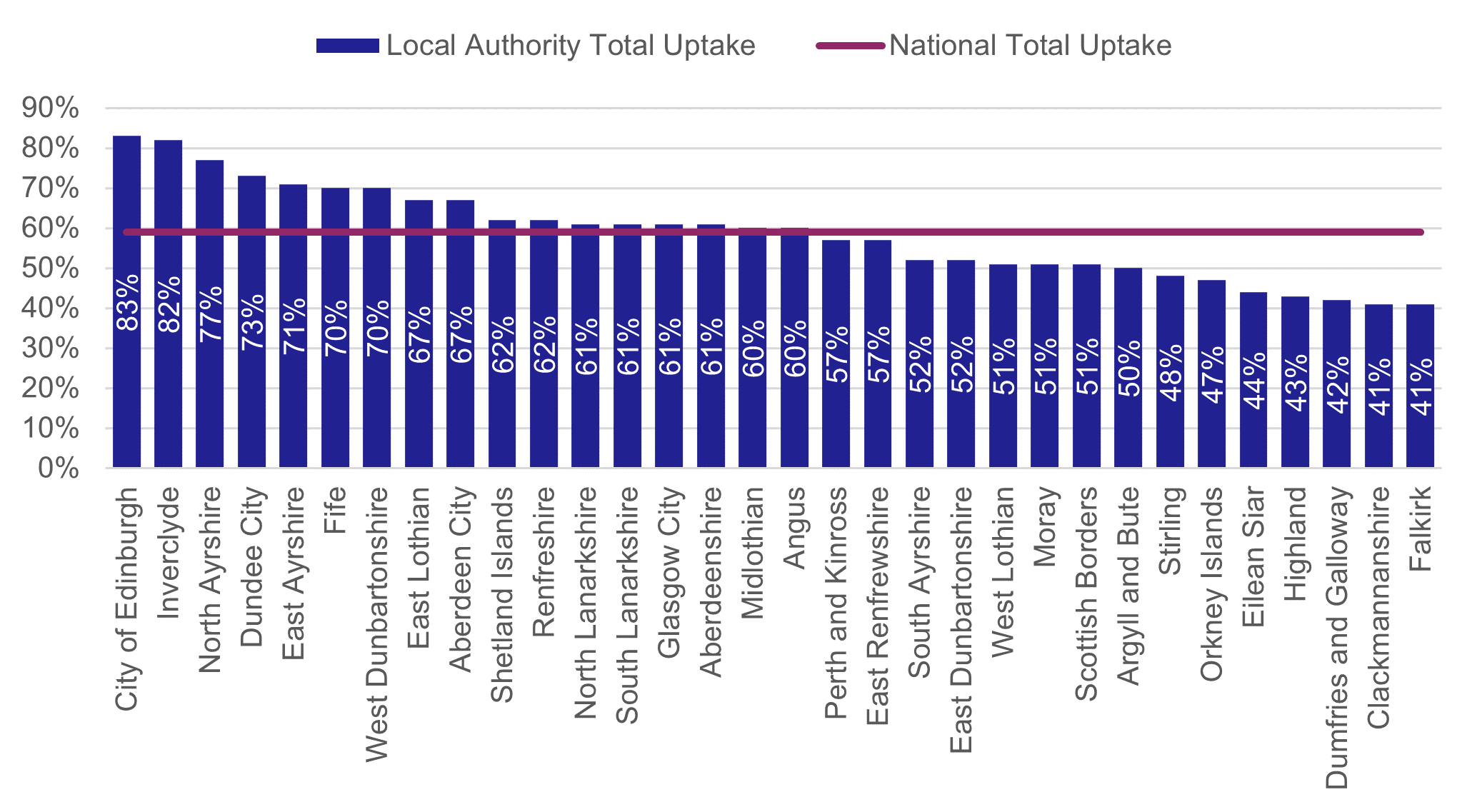
Uptake of the Young Persons’ Free Bus Travel Scheme was also high among follow-up survey respondents with 74% having signed up and used the scheme. The responses were as follows:
- Yes, signed up and used it: n=7,993 (74%)
- Yes, used to use it but stopped: n=263 (3%)
- Yes, signed up but not used it yet: n=588 (5%)
- No, not signed up: n=1,674 (15%)
- Don’t know: n=357 (3%)
Application Process
Parents must apply for the Young Persons’ Free Bus Travel Scheme on behalf of children aged under 16 years old, while young people aged 16-21 must apply themselves. Two types of free travel card are available, a National Entitlement Card (NEC) or Young Scot National Entitlement Card (Young Scot NEC). The NEC provides free bus travel only and is available to all eligible young people. Meanwhile, the Young Scot NEC combines the free bus pass with the Young Scot card, and can be used as age identification and for other discounts, as well as free bus travel, this is only available to eligible young people aged 12+.
Various application processes have been/are available for the scheme, often with different methods being offered in different locations and at different points in time. Applications can be made directly online via get your NEC. Each local authority also offers an application process for their residents, and some schools facilitate applications via the Parents Portal. Upon the launch of the scheme, some schools also offered parents/carers the opportunity to sign their children up for the scheme via hard-copy applications (with some potentially continuing to offer such an application process on an annual or ongoing basis). Those turning 12 years old and applying for a Young Scot card for the first time are also able to opt for the free travel scheme to be activated (i.e. apply for the Young Scot NEC) as part of a single application process. Some with existing Young Scot cards are able to activate the free travel scheme on their card via the Young Scot App, while others, with older Young Scot cards are required to apply for a replacement or new Young Scot NEC. Following feedback on the application process shortly after the scheme launched, the main getyournec.scot application was updated in June 2022 to provide a better user experience.
Follow-up survey respondents were asked how easy they had found the application process. Of the 8,379 respondents who had signed-up and provided a rating, 64% had found the application either very or fairly easy, compared to 25% who had found it very or fairly difficult (the remaining 11% had found it neither easy nor difficult).
Those who had applied more recently found the application process easier compared to those who applied when the scheme first launched, with greater proportions finding this either very or fairly easy since June 2022 (i.e. after the getyournec.scot application had been updated). There was also a marked improvement in how easy respondents had found the getyournec.scot application process between the launch of the scheme and more recently, rising from 57% who found it either very or fairly easy when applying over 12 months ago, to 73% of those who applied in the last two months (see Table B1 in Appendix B). Those who applied via the Parents Portal or through their school were also more likely to find the process very or fairly easy compared to the other application methods available. Table 3 & 4 provide full ratings disaggregated by when and how the application was made while Table B1 in Appendix B outlines ease of the application process by the timing and method of the application.
| When Applied | Very or Fairly Easy | Neither Easy nor Difficult | Very or Fairly Difficult | Total (n) |
|---|---|---|---|---|
| Over 12 months ago (i.e. Jan - May 2022) | 63% | 10% | 27% | 4,563 |
| 7-12 months ago (i.e. June - Nov 2022) | 66% | 12% | 22% | 2,212 |
| 3-6 months ago (i.e. Dec 2022 - March 2023) | 66% | 12% | 22% | 809 |
| In the last two months (i.e. from April 2023 onwards) | 71% | 10% | 19% | 399 |
| Application Method | Very or Fairly Easy | Neither Easy nor Difficult | Very or Fairly Difficult | Total (n) |
|---|---|---|---|---|
| Online at getyournec.scot | 59% | 11% | 30% | 3,904 |
| Online at parentsportal.scot | 70% | 6% | 24% | 954 |
| Via the local council (e.g. library, council website, etc) | 63% | 11% | 26% | 1,144 |
| Through the school | 76% | 11% | 13% | 1,686 |
Feedback from focus groups revealed that both parents/carers and young people (who used the scheme) felt that the application process could be clearer, faster and easier overall:
“To find the application and do it online was quite hard, mainly because I had to verify all of my own information first on one system before I could then apply for the card. And when the card did come through, I was told I needed to do something with the card to activate it, but when I tried to log in to my original details, it kicked me out and said I was over 21. It was very confusing. Maybe just a website with big shiny lights that says ‘apply here’ would be easier. There was a lot of ID that was needed for the process.” (Parent/Carer of Scheme User)
Some questioned why children could not automatically be issued with cards by their schools, and it was suggested that this might help families where English was not their first language and who may find the application process difficult.
Issues with the application process were also highlighted as a reason for not using the scheme among non-users, and as presenting a barrier to accessing it - this is discussed in more detail below.
Use of the Young Persons’ Free Bus Travel Scheme
Based on usage data provided, a total of 62,178,745 trips had been made using the Young Persons’ Free Bus Travel Scheme between January 2022 and April 2023. Figure 2 outlines the number of trips made using the scheme since its introduction, and shows general growth month on month, although there were dips in usage noted typically around holiday periods (e.g. July, December, and April). Peak usage was noted in March 2023, with over 6.3 million journeys recorded.
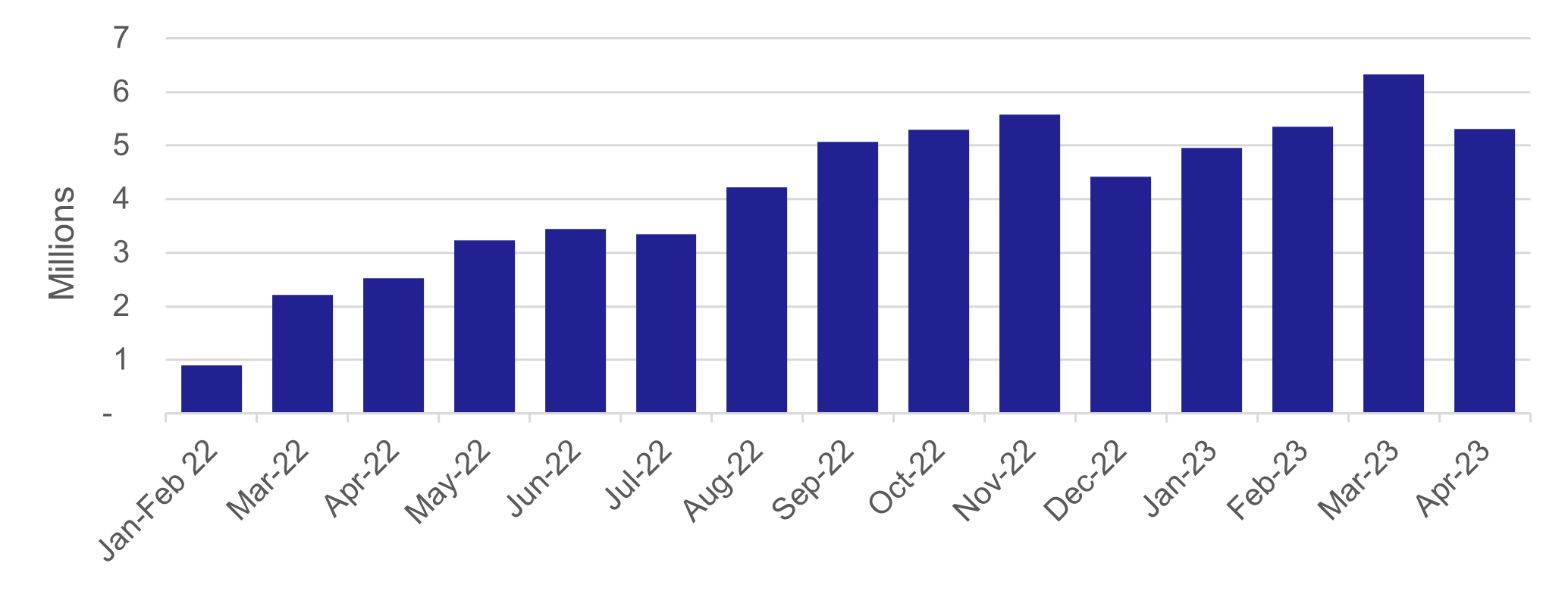
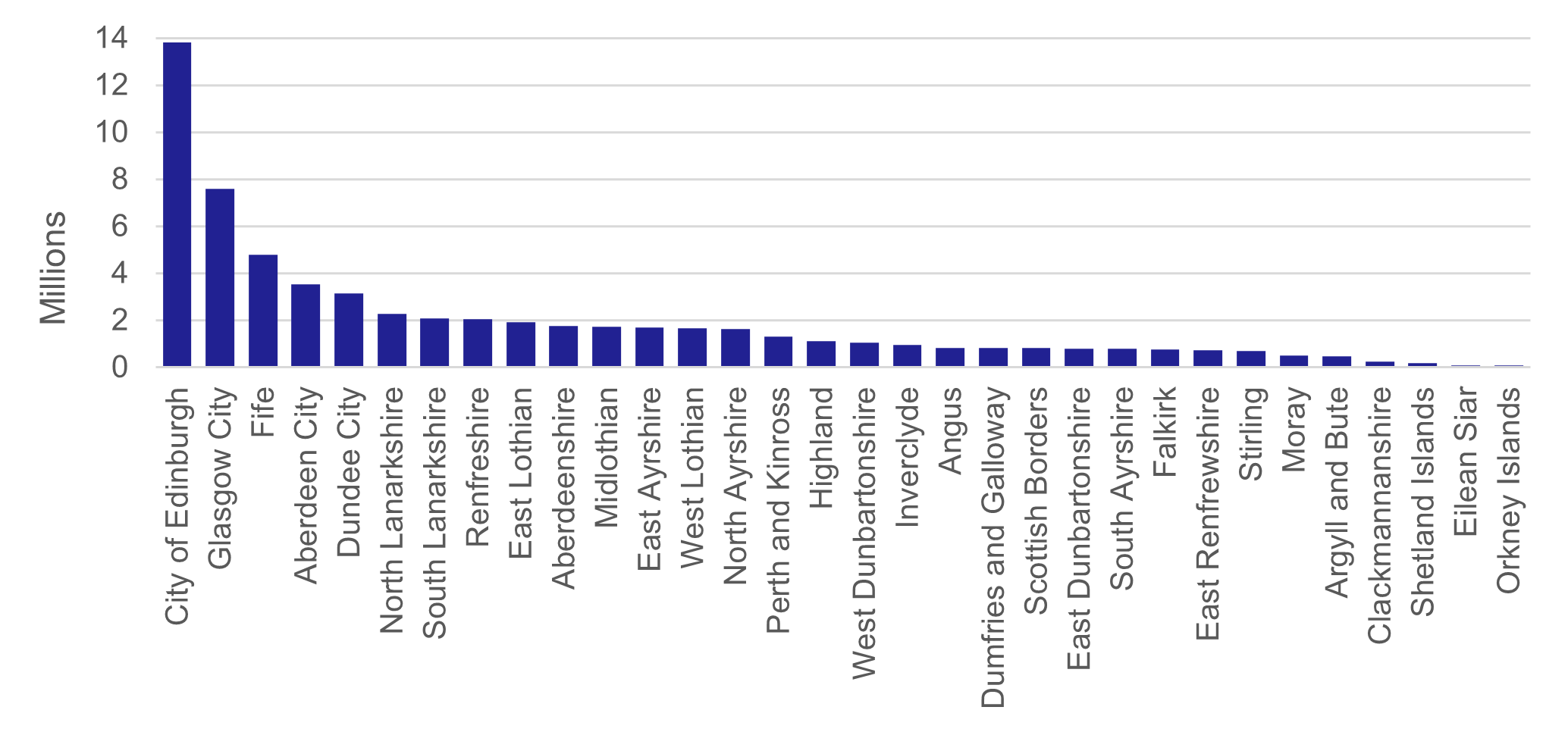
Figure 3 details the total number of journeys made using the Young Persons’ Free Bus Travel Scheme by the originating local authority (i.e. where the card holder boarded the bus). The total number of journeys made since the scheme was launched ranged from 79,301 originating in the Orkney Islands to 13.8 million originating in the City of Edinburgh. The different population sizes by local authority also need to be borne in mind when interpreting this data, however.
Large city authorities (i.e. Edinburgh, Glasgow, Aberdeen and Dundee), plus Fife, generated the largest volume of journeys, while the island authorities (Shetland, Eilean Siar and Orkney) generated the lowest volume of journeys, followed by Clackmannanshire.
Figure 4 outlines total uptake and usage for each local authority area and highlights some interesting findings. For example, while Inverclyde had the second highest uptake, they had relatively low usage rates. Similar patterns can be observed in North Ayrshire and the Shetland Islands. Conversely, Glasgow ranked 14th for uptake but had the second highest volume of journeys made. This may be driven (at least partly) by the extent of the bus services/network available in such locations.
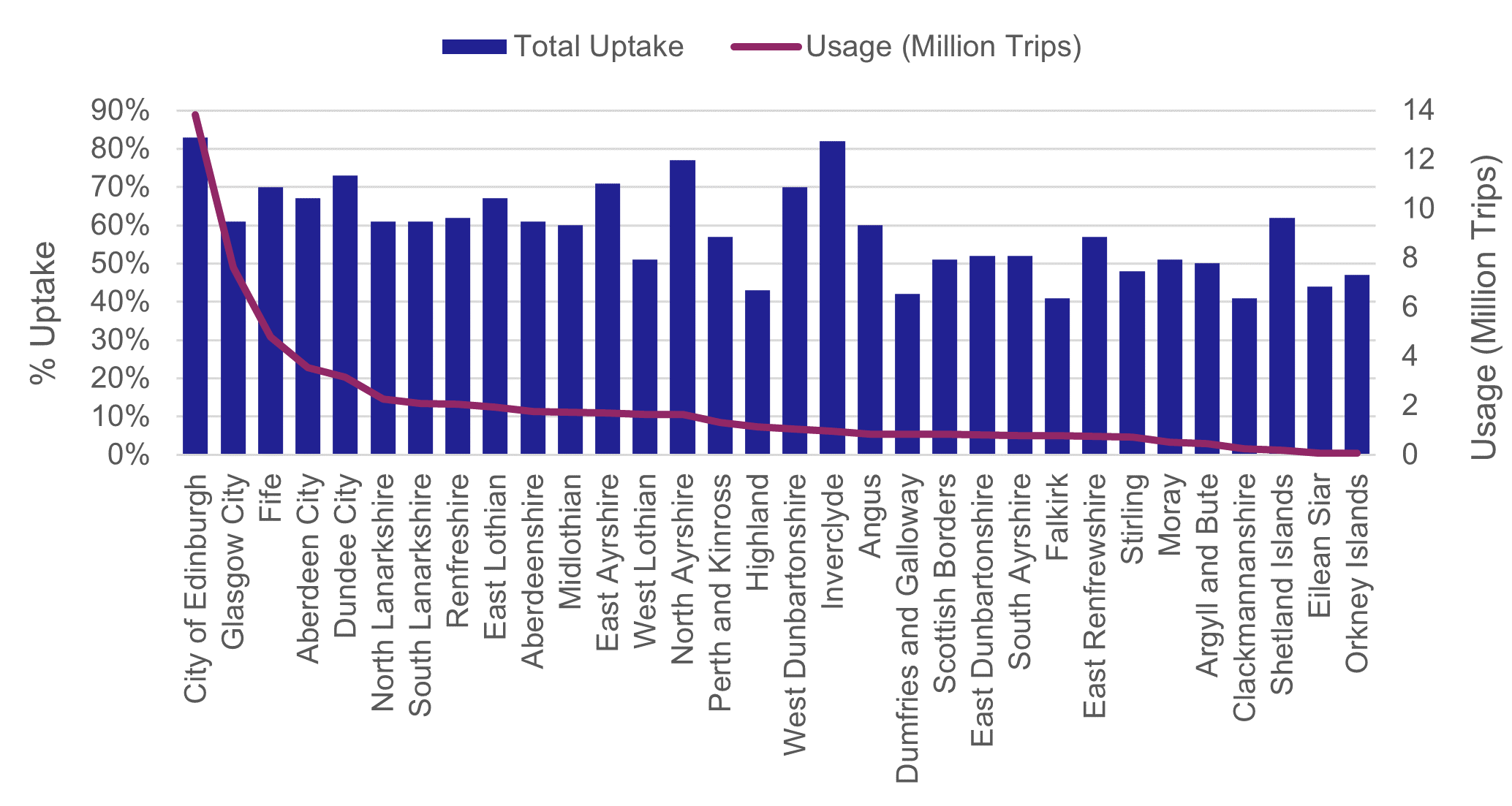
NECPO usage data also showed that most trips were made by those aged 16-21 and that females generated a higher number and proportion of trips than males:
Trips by Age Group:
- Journeys taken by those aged 5-11: n=6,649,009 (11%);
- Journeys taken by those aged 12-15: n=18,563,170 (30%); and
- Journeys taken by those aged 16-21: n=36,965,895 (59%).
Trips by Gender:
- Journeys taken by females: n=28,436,793 (46%);
- Journeys taken by males: n=24,374,610 (39%); and
- Journeys where gender unknown: n=9,367,342 (15%).
The data also showed that more trips occurred during the week (49 million journeys) compared to at weekends (13 million journeys). This may be linked to the perceptions held by professional stakeholders that greater numbers of school pupils were using the bus to travel to school (see the Stakeholder Feedback Report), with the Hands Up Scotland Survey also indicating a slight increase in school pupils using bus to travel to school (as discussed in Chapter 3). Some young people who attended the focus groups also suggested that they had fewer places to go/be at the weekend (particularly on Sundays). Most journeys were also made either during the morning or evening rush hour periods or during the day (see Table 5). Those aged 16-21 were the most prevalent users of the free bus travel between midnight and 6am, and again between 7pm and midnight, while males were more likely than females to use the free bus travel between midnight and 6am.
| Age/Sex | 00:00 - 05:59 | 06:00 - 09:59 | 10:00 - 15:59 | 16:00 - 18:59 | 19:00 - 23:59 |
|---|---|---|---|---|---|
| Age 5-11 | <1% | 11% | 13% | 10% | 5% |
| Age 12-15 | 3% | 33% | 30% | 31% | 25% |
| Age 16-21 | 97% | 56% | 57% | 59% | 70% |
| Male | 55% | 38% | 38% | 39% | 45% |
| Female | 43% | 44% | 46% | 46% | 45% |
| Prefer not to say | 2% | 18% | 16% | 15% | 10% |
| TOTAL | 259,801 (<1%) | 11,928,188 (19%) | 25,840,011 (42%) | 15,677,272 (25%) | 8,473,473 (14%) |
Among focus group attendees, travel was also determined by time of day (often for safety concerns). Most young people under 18 indicated that they would mostly travel during the day, that they were less likely to travel at night, and were less likely to travel long distances, with various (often self-imposed) curfews/restrictions suggested:
“On the bus, I would probably just go about 30 minutes away.” (Scheme User)
“Not travelling really late, maybe 7pm or 8pm. If it’s wintertime, I won’t really go out after 7pm or 8pm.” (Scheme User)
Meanwhile, some older young people indicated that they used the bus mainly at night:
“Maybe when I was younger but I’m 17 now and I’ve been on a bus quite late, about 10 o’clockish when I’ve been at work late, and there’s been no issues.” (Scheme User)
Respondents who used the Young Persons’ Free Bus Travel Scheme in the follow-up survey also indicated high levels of usage, with over three quarters (78%) using it at least weekly. The full breakdown of responses by how often they used free bus travel was as follows:
- 5 days a week or more: n=3,021 (38%)
- 3-4 times a week: n=1,725 (22%)
- Once or twice a week: n=1,463 (18%)
- Once or twice a month: n=1,079 (14%)
- Less than once a month: n=349 (4%)
- Rarely : n=297 (4%)
Figure B1 in Appendix B outlines frequency of use by local authority and shows that areas with high total usage figures do not always result in high frequency of use by individual users. For example, Clackmannanshire was among those with the lowest uptake and total number of trips made but ranked 7th for the proportion of survey respondents using the scheme five days a week or more, and ranked 2nd for the proportion using the scheme at least weekly. Conversely, Edinburgh City Council had the highest uptake and total number of trips made but ranked 13th in relation to the proportion of follow-up survey respondents who used the scheme five days a week or more.
It should be noted, however, that usage data and frequency of use may also have been impacted by the availability/quality of local bus services as well as the availability of alternative public transport options. For example, Dundee City showed high uptake, a high number of total trips and ranked highest in terms of individual users frequency of use, probably linked to the extensive bus network available across the city and a lack of other public transport options.
Reasons for Not Using the Scheme
Those who had previously signed-up for the Young Persons’ Free Bus Travel Scheme but had stopped using it, those who had signed up for the scheme but not used it yet, and those who had not signed up, were asked to outline why. Figure 5 details the responses.
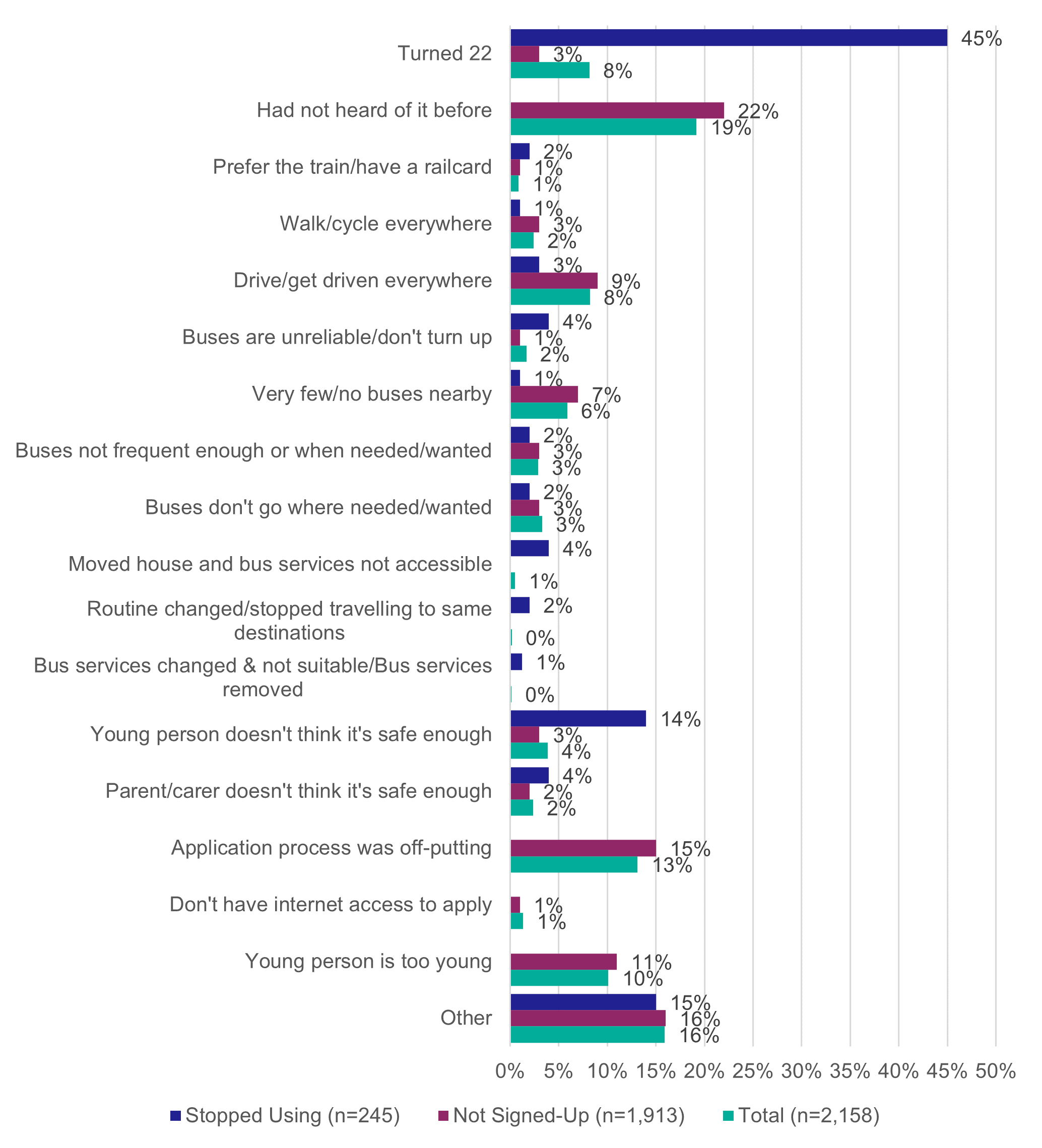
Reasons for Stopping Using the Scheme
The main reason why young people had stopped using the scheme was that they turned 22 years old and were therefore no longer eligible (45%). This was followed by the young person not thinking it was safe enough (14%), while 16% indicated a range of accessibility issues with local bus services.
Other reasons given for young people having stopped using the scheme included that the free travel card had either expired, been lost or stopped working, and it was difficult to apply for/obtain a replacement:
“His card ran out in March when he turned 12 and I'm having trouble renewing.” (Follow-up survey respondent)
“Card was lost. Can't reapply as my daughter doesn't currently have a passport… She has a card registered via her school and her current address with her photo and only needs a replacement… It is now costing her a lot of money weekly as she is over 16 and paying adult fares each time when she is entitled for this to be free.” (Follow-up survey)
A few respondents also indicated that their child was too young to travel alone but it was too expensive for fare paying adults to accompany them on the bus:
“It is too expensive to also pay for parents to travel by bus. It is cheaper to drive than pay for two parents just to use free child pass.” (Follow-up survey)
Reasons for Not Signing Up for Scheme
The main reasons why young people had not signed up for the scheme included:
- 22% had not heard of it;
- 15% said the application process was off-putting;
- 11% said the young person was too young;
- 14% identified issues with bus services (including 7% where very few/no buses are available nearby, 3% where buses do not go where needed/wanted, 3% where buses were not frequent enough or when needed/wanted, and 1% where buses were unreliable/not turning up); and
- 13% indicated they preferred or used other modes of transport (9% drove/were driven, 3% could walk/cycle everywhere, and 1% preferred the train).
A further 16% indicated there were ‘other’ reasons for not using the scheme. Again, these largely related to problems with the application process - either difficulties experienced with the application process itself, or that an application (or in some cases multiple applications) had been submitted but no card ever received:
“We have tried continuously to apply but the application process is rubbish, it constantly leads us to a dead end.” (Follow-up survey respondent)
“After trying to register in January 2022, young person is now on the 5th attempt (3x online, 2x via local library) to receive the bus pass while their parent is slowly losing the will to live. Just tried again recently and currently waiting for outcome.” (Follow-up survey respondent)
Similar difficulties were also discussed by eligible non-users across the focus groups, where problems and negative perceptions around the application process was highlighted as one of the main reasons for not signing up to the scheme:
“Discussions with friends and people I knew that said the process was really quite complex and they weren’t hearing back, so I didn’t take it any further, that kind of put me off straight away.” (Parent of Eligible Non-User)
Across both the survey and focus groups with non-users, it was also suggested that there was a lack of help for parents and young people who were having issues with the application, and a lack of advice and feedback for those who submitted applications but never received the travel card. Respondents in these situations suggested they either received no response when they contacted organisations for advice or updates about their application, or were passed from one organisation to another generally with no success:
“Despite multiple applications no pass has been received, and lack of help from local authority despite multiple times asking for help.” (Follow-up survey)
“Filled in the form given to us by school and never received my sons card. Have made enquiries to the school, local council and Transport Scotland but haven’t been able to get any answers on what has happened to his bus pass.” (Follow-up survey)
Specific difficulties with the application process itself tended to focus on:
- Lack of full birth certificate (it was noted that only the abbreviated version was issued currently with parents/carers having to pay for copies of the full version, this was not issued to parents at birth as standard), or difficulties caused by birth certificates issued outside of the UK;
- Lack of photo ID for both parents/carers and young people themselves;
- Websites not user friendly - several suggested they were ‘sent round in circles’; and
- The online application process timed out and applicants needed to start again.
While the need for certain documentation appeared to be a widespread issue for many parents and young people, it was particularly restrictive for young people in care/accommodated children, where carers may not have access to these original documents and are not the birth parent:
“My YP [young person] is a looked after and accommodated child. I have been trying to apply for a card but it’s very difficult as I am not his birth parent.” (Follow-up survey)
“Tried to fill in the form as a foster carer and it would not let me fill it in completely. Mum and social worker has tried to fill it in but again had trouble.” (Follow-up survey)
In addition to those who did not know about the scheme, a few respondents also indicated that they did not know how to apply, or that they didn’t know the eligible age groups (particularly the younger age limit) and again, a lack of information or response from agencies following queries around this were noted. Others were aware of the scheme but simply had “not got round to applying yet”.
As well as being an issue for 14% of survey respondents, a lack of suitable and reliable bus services nearby was also a key issue for non-users in the focus groups. Many suggested that taking the bus was not an option as either there were no buses available nearby, or the service either took too long (longer than other options, including walking in some cases), was unreliable (with one indicating they had nearly missed job interviews as a result of the bus running late), or did not go where they wanted/needed it to. Others, who lived in/near the centre of towns/cities felt that everything was within walking distance and so they had no need to use buses - they largely suggested they would also prefer to use the train for longer journeys. Typically, it was felt that the expected difficulty in applying for and obtaining the Young Persons’ NEC was not outweighed by the benefits it would provide due to the lack of services or current levels of bus use:
“I’d either drive or walk everywhere, or get the train if I have to get public transport, because a train for me to [nearest city], including the time it takes for me to drive to the train station is 20 minutes, but the bus to [nearest city] takes an hour and 10 minutes, so I’d rather pay with a Young Persons’ Railcard… The bus is also very infrequent but the train is every 10 minutes.” (Eligible Non-User)
Again, a few follow-up survey respondents highlighted the cost of adult bus fares as a reason for not having signed-up for the scheme, particularly where children were considered too young to travel alone or where the child had a disability or ASN so needed to be accompanied. Several also indicated that they/their young person already had a concessionary bus travel card. A few had also chosen not to sign-up due to their objections to the scheme, as they disagreed with universal benefits and/or the scheme on principle.